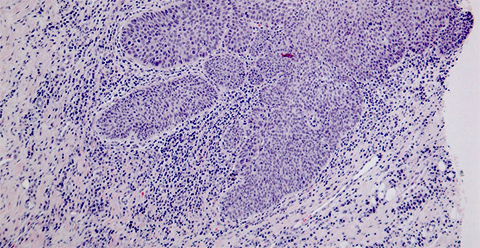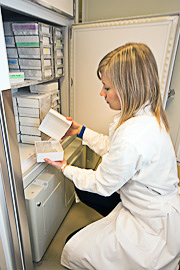HPV Infection in the Head and Neck Region Previously Considered as an STD Is Linked to Western Way of Life
Infections that were previously considered a nuisance of sexually active women occur equally on men and even in infants.

Histological picture showing a squamous cell carcinoma in a biopsy sample taken from a tongue.
Research carried out at the Institute of Dentistry of the University of Turku and at the Department of Obsterics and Gynaecology of Turku University Hospital reveals new information about HPV infection in the head and neck region.
HPV, i.e. Human papilloma virus, is a DNA virus that is transmitted through mucous membrane contact. It causes genital warts, papilloma and pre-cancers that can at the worst progress into cancer.
At the moment, already over 200 different genotypes of HPV viruses have been discovered, 40 of which have been classified as viruses that infect the mucous membrane and about 20 are high-risk strains that can possibly cause cancer. About 30 percent of the severe pre-cancer cell changes in the cervix progress into cancer if left untreated.
Although cervical cancers and genital warts linked to HPV infection have decreased because of the effectively organised mass screening programs, the incidence of cancers in head and neck region, for example in the base of the tongue or in the tonsils, has increased in all Western countries.
What is significant is the connection of the HPV infections to other cancers.
–Even if cervical cancer occurs less frequently than before, cancers on the head and neck region area are increasing. Over 70 percent of oral and neck cancers have been linked to HPV infection, says Professor of Oral Pathology Stina Syrjänen.
Pioneering Research
Syrjänen has researched HPV infections at the University of Turku since the 90s. Her research group was the first to present the original observation on the association of HPV with a subgroup on head and neck cancers already some 30-year ago. In addition, Syrjänen has led many longitudinal studies where the research subject has been, for example, women’s oral HPV infections and vertical transmission of HPV infection from mother to her new-born. Her latest project has been the joint research of the Institute of Dentistry and the Department of Obstetrics and Gynaecology that studies the HPV infections in family members and especially HPV infections that have been transmitted from one family member to another.
The sufficiently long observation time of the studies has made it possible to create theoretical models. However, it is still not clear why some of us contract a chronic HPV infection which is known to be the key event in the carcinogenesis caused by the HPV.
–The natural progress and transmission mechanisms of the virus are still partly unclear. In most of the world and in Finland as well, the most common high-risk genotypes of the HPV are 16 and 18, but, for example, in many parts of Africa, HPV type 58 is the most common strain that has been associated with the development of genital pre-cancers.
What makes the research problematic is that most of the HPV infections go away on their own. In addition, the virus does not always show up on tests even if it exists. So you can carry the disease without knowing.
Infection Transmitted from Mother to Child
Doctoral Candidate Anna Paaso is researching the spread of the HPV infections and the immunological reaction caused by the virus.
She has observed that when women who have the type 16 virus became mothers they infected their child during pregnancy or birth. The virus was transmitted to the same degree to girls and boys.
The research surprisingly revealed that these children have immunological memory cells for the type 16 virus. Therefore, the mother’s illness had led to the child to have possible HPV immunity without a vaccine. Although transmitting the disease to a new born can sound frightening, it might not normally cause any harm to the child.
–When the new born contracts the virus from the mother, he or she will also receive maternal antibodies to fight it. Mother’s infection can therefore create immunity for the child. The child who is infected develops an immunological memory which can possibly protect the child against later HPV infections, says Paaso.
According to Syrjänen, the situation might be different for children whose mothers haven’t had time to create antibodies to the virus. In that case, the children could have caught the HPV infection from their mothers during childbirth, but not the antibodies that protect from the infection.
–It takes six months from catching the disease to create antibodies, specifies Syrjänen. Our research has undeniably shown that childbirth plays a considerable role in the transmission of the HPV infection from mother to child. For example, in Brazil, where 85 percent of deliveries are still performed with Caesarean section, the portion of head and neck cancer caused by HPV infections is only six percent, she says.
The most important challenge in the research is to find out which of the children get a chronic HPV infection and where in the body it manifests.
Way of Life as a Risk Factor
Also Western way of life has been discovered to have a connection to head and neck cancers caused by the HPV infections. The most common causes for these cancers have earlier been smoking and the substantial use of alcohol, but now HPV’s role as the cause of head and neck cancer is becoming more significant than before.
Nearly everyone will at some point of their life contract an HPV infection, but only in a few cases infection will progress into a chronic infection and pre-cancers. For this to happen, other risk factors, such as sexual behaviour, smoking, hormones and other infections, have to be involved.
Syrjänen says that HPV infections should not be considered only as a sexually transmitted disease anymore. Furthermore, she highlights that the same types of virus occur similarly on women and men and both in the oral, anal and the genital areas. Both sexes also spread the virus.
The best way to protect oneself from the virus is to get vaccinated. However, the vaccinations are considered unequal at the moment, as the HPV vaccination is the only vaccination in the vaccination programme that is solely given to girls.
Now that it is clear that both sexes spread the infection, the role of the vaccinations is even more important. It is being discussed at the moment that should boys be vaccinated as well.
–On the level of the whole population and from the point of view of the spread of the virus, the vaccination will not be effective if it covers fewer than 80 percent of the population. At the moment, the coverage in Finland is only 50 percent which is considerably low in comparison to many other countries. However, the vaccination will protect individual people, says Syrjänen.

Professor Stina Syrjänen and Doctoral Candidate Anna Paaso
Text: Matilda Herjanto
Photos: Stina Syrjänen, Matilda Herjanto